Slainté! Did everyone have a good St. Patrick’s Day yesterday? We did too. As a bonus, this article features an interesting aspect of Irish mythology! Read on, and learn all about your friendly neighborhood yew tree (in many parts of the world).
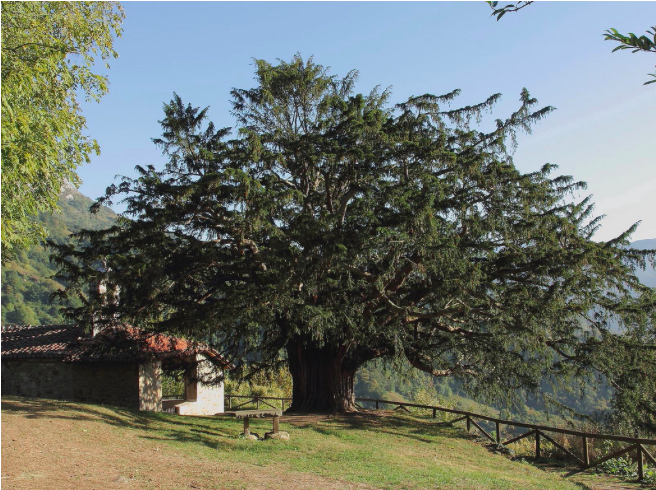
Meeting the Taxus Baccata
I was in Asturias, northern Spain, the first time I heard about it. It was a stormy night, perfect for the introduction of such an enigmatic species, and we were in the patio of a medieval palace, a building not far from Oviedo’s Cathedral, yet older than the Cathedral itself. Motivated by the little box tree, stoic below the rain in the ancient patio, my brother in law Tomás asked me if I knew what a tejo was. I supposed it was a type of wood, but I was far from sure. He explained that it was a revered tree in those parts, adding that the unique característics of its wood made it the ideal material for the construction of bagpipe whistles. (The bagpipe is a common denominator among peoples of Celtiberian descent in the Iberian Peninsula, such as Galicians, Asturians, and Cantabrians.) Then Tomás told me about the extraordinary longevity of tejos, and cautioned me against its lethal toxicity. “You won’t make it to Pravia,” as his mother likes to say in reference to the closest emergency room, a 25-minute drive downhill from the house where we were staying out in the mountains.
The Spanish word tejo derives from the Latin word taxus, also included in scientific name of the tree: Taxus baccata. The Asturian form of the word, teixo, where the x is pronounced sh, seems even closer to the original name given by the Romans to the species. It was only later, back in the old village, that I could look the term up to discover that the tejo was none other than the yew. I realized a rather large one had been growing in the abandoned house next door for what looked like a real long time. That moment marked the onset of an almost nine-year-long obsession.
I soon identified a few other individuals growing right in the vicinity of our village, some very impressive ones too. It was easy to spot their thick, dark and elusively triangular crowns, like proto-human spearheads, near churches, in privately owned land, or in small town parks. The knowledge that a little over fifty of the dark green needles of any yew have the potential to kill a person added an aura of solemnity to my encounters with each of these trees, even with some of the smaller, less threatening-looking individuals. In late September, when I first started observing them up close, the little arils—fleshy, red fruits that coat each yew seed—sparkled like rubies in the thick darkness of the foliage. These sweet and edible globules are the only non poisonous part of the tree. Birds and other animals that feed on the arils, help spreading the seeds—which are toxic—as they pass undigested through their bodies and get later deposited on the ground with their droppings. Looking deep into their fruit-bearing crowns, deep into blackness where boughs branch out from the trunk, it occured to me that some of those areas buried in darkness hadn’t see the sunlight in possibly hundreds of years.
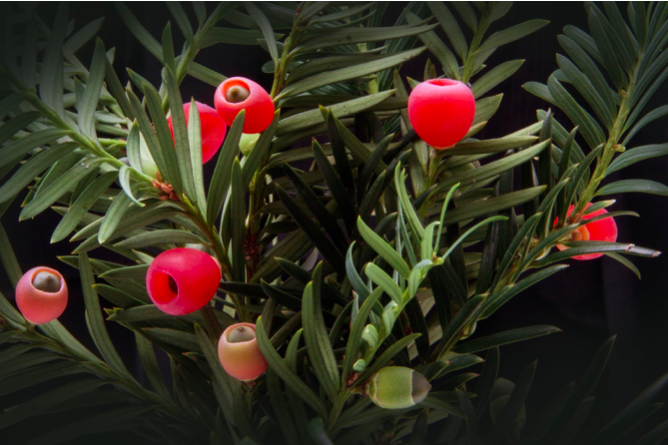
A Connection to the Divine Realm
Back home, in Brooklyn I realized that the yew had been there all along, thriving in yards and gardens all over the city. We are talking, of course, about tamed yews, most of them pruned into hedges to outline the perimeter of a court or a walkway, but some standing as little-to-medium size trees as well. Once one learns to recognize the dark hue of its needles, the yew becomes a conspicuous element in the urban landscape. We clearly appreciate the ornamental qualities of the species. But what is behind this purely horticultural fondness for the yew?
The relationship between yews and people is old and deep. Yews have been revered by humans in Europe and Asia for thousands, maybe tens of thousands of years. The ancient Greeks believed the yew to be the sacred tree of Hecate, the nocturnal goddess associated with death, the moon, necromancy, and witchcraft. The vengeful furies were also thought to dwell in a grove of yews, and yews had the power to purify the dead as they entered Hades.
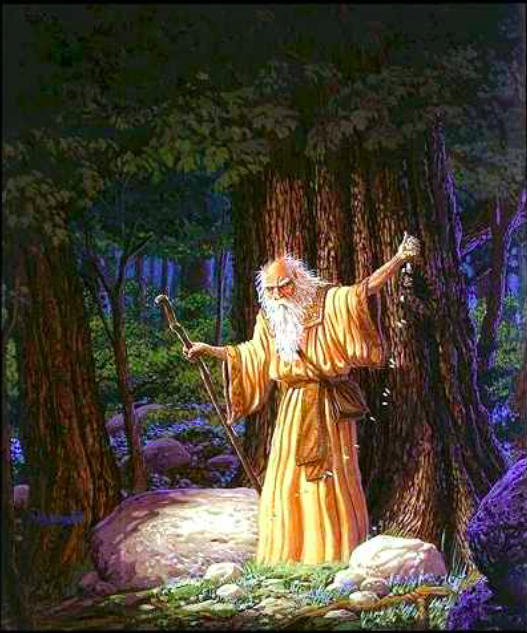
It has been said that in the Celtic world the forest is a sanctuary. In that sanctuary, few presences are as important as that of the yew. The evergreen was associated to Dadga, one of the main Tuatha Dé Danann, the ancient divine beings that populated Ireland in a very distant mythical past. The god, often depicted as a chief or a druid, is also known as Eochu, which derives from an epithet meaning “he who fights with the yew.” It is, in fact, not uncommon to find yews in the names of early Irish deities. Even the word Hibernia, the pre-Christian name of Ireland, could be translated as “yew island”.
The longeve yew is also a revered evergreen in Asia. Magnificent yews grow in the Buddhist temples and Shinto shrines of Japan. The Hakusan Jinja yew, a shrine tree protected as a holy site since 1673, is believed to be a passageway between the visible world and the divine realm. In the Shinto faith, where all evergreens are considered sacred, such enshrined trees are known as shinboku, and can be recognized by the red torii set in front of them.
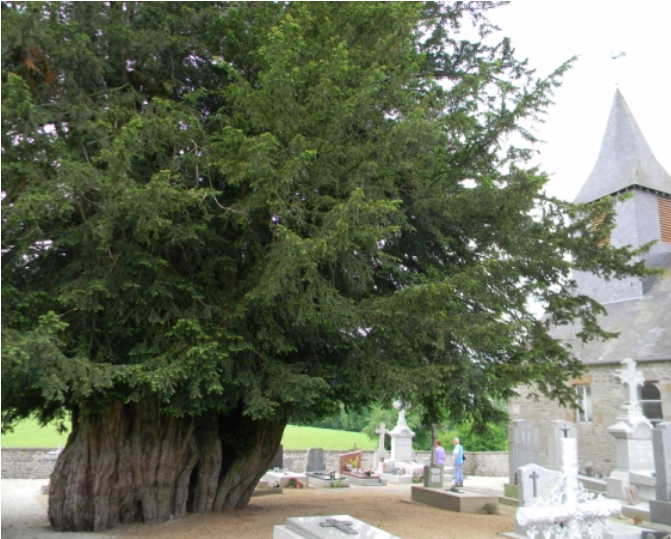
Even today we see remains of that ancient identification of the yew with the world of the spirits. Yews can still be found in modern churchyards, graveyards, and cemeteries. It is said that many early churches in Europe were built next to yews because these trees were already considered places of worship. The red arils, like the berries in the holly, and the apparent immortality of the evergreen leaves of the tree made it a symbol that could easily convey the Christian idea or resurrection and eternal life, both fundamental to the Christian faith. The old forest gods became symbols of the only God of the new religion.
Life and death have always been associated with the dark silhouette of yews, and that explains its common presence in cemeteries and other funerary places. But their solemn appearance still compels us to imagine fabulous explanations. One legend I like tells that each of the roots of graveyard yew reaches into the mouths of all the dead, so that their secrets may leave their bodies and travel up to the tree where they are finally liberated in the wind by the leaves. Yews are indeed deeply rooted in our collective imagination. Their imposing presence in the landscape can fire our species’ ability to create stories.
Warrior and Healer
In the first century B.C., Julius Caesar registered the powerful toxicity of the Taxus baccata in his own written account of the dead of Catuvolcus, king of the Eburones, who seeing the devastation left by the Romans in their extermination campaign, resorted to taking his own life by drinking the juice of the yew leaves. Pliny the Elder also accurately describes the poisoning qualities of the yew in his Natural History, even mentioning the use of the yew extract to poison the tips of arrows. Other ancient sources, such as the Greek geographer Strabo, the Roman poet Silius Italicus or, a few centuries later, the medieval scholar Isidore de Seville, write about the use of the poisonous yew as a means of suicide among Cantabrians, Asturians, and other Celtic Iberian tribes fought by the Romans in their expansion.
It seems obvious that the association of yews with death stems from the toxic properties of the Taxus baccata. However, yews were also deadly in a different way. The extraordinary combination of hardness and flexibility in yew wood makes it the ideal material to make the longbow, the armor-piercing weapon that gave English archers an advantage over their French enemies during the Hundred Years War. The demand for yew wood was such that it brought the species to the verge of extinction in Europe. It could even be said that the introduction of gunpowder and the invention of firearms in the late middle ages saved the European yew from total annihilation.

In much more recent history, the demand for taxol, a chemical contained in yews bark, also put the population of American Western yews (Taxus brevifolia) under a lot of stress. The anti-cancer drug derived from taxol has proven to be clinically effective against ovarian, breast, and lung cancers. This created an enormous demand for the tree, specially for older individuals with higher concentrations of taxol in their tissues. Fortunately, over the years semi-synthetic replacements have been produced and are still being perfected. The harvesting of Western yews is no longer permitted in U.S. National Parks. Yews, we have seen, can easily take a life. But they can also save many others.
Millenia Old

Yews are among the oldest living beings on the planet. This fact, along with the proverbial toxicity of all his parts except the fleshy arils, helped shape its reputation as a magical, sacred tree.
Calculating the age of a yew is no easy task, and one of the reasons lies in the unique ability of the yew branches to grow toward the ground and take root, which adds extra support to their crowns as they grow heavier in older age. Like the mythical Phoenix, the yew can be reborn out of their own ashes: new roots can grow inside a trunk hollowed out by decay and the fill empty space with new, healthy timber. These two unique qualities, along with the natural resilience of yew wood, make it possible to find living individuals that are literally thousands of years old.
Great famous old yews can be found everywhere in Europe, with many remarkable examples in Britain, France, and Spain. The Bermiego Yew, in Asturias, with its near perfect morphology —a picture perfect straight, thick trunk with a dense crown as broad as a hill—is one of the oldest living trees in Europe, with an estimated age of 2,000 years. It was declared a natural monument in 1995, and, like all wild yews in Asturias, is protected by the law. In the town of Crowhurst, England, an ancient yew has been photosynthesizing and breathing in the same spot for what some have estimated to be near 4,000 years, though experts say that the tree is probably closer to 1,500 years old. This specimen suffered the brutality of being hollowed out by villagers sometime in 1820. They even put a table inside with a capacity for several people and added a little door to access the gigantic trunk. Amazingly, the tree survived and can still be visited today. A third remarkable example is the Scottish Fortingal Yew, one of the most celebrated and ancient members of the species. Its age has been estimated between 2,000 and 3,000 years old and it’s considered by some the oldest tree in Britain. There are several monumental yews in France. One of them is the enormous yew at the cemetery of the church of Notre-Dame-de-la-Nativité, in Le Ménil-Ciboult, a village in the department of Orne, in Normandy. With a girth of close to 13 meters, it appears to be thickest yew in all of France. We don’t have any information about its age, but it sure does look old, probably older than the village itself.
Yews of New York
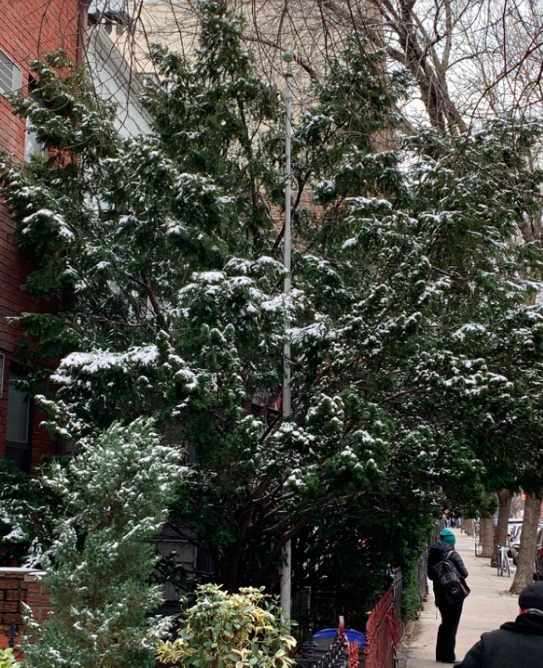
We might see the yew as the gloomy messenger of blackness and silence depicted in Sylvia Plath’s “The Moon and the Yew Tree.” Or we might see it as a scale model of Yggdrasyl, the tree-universe of the Norsemen that so many have identified as a yew. The meanings we attached to the natural world are also a reflection of our emotions, and the image of a solitary yew in a quiet street is sure to stir those emotions and fire our imagination.
Here in Greenpoint, a few blocks from my home and my place of work, I have identified four small yews, two of them on Huron Street, one on India and the fourth one on the beautiful Noble Street. They all grow on privately owned land. I first noticed the ones on India years ago, growing in the front yard of a house that seems currently abandoned or at least not in use. The gate to the yard is firmly tied with a white electrical wire and tells me that trespassers aren’t welcome. These two yews remind me of the twin girls in Stanley Kubrick’s The Shining. I imagine their roots tightly interconnected underground, sending chemical signals to each other about secrets kept since they were planted there. Only a block from there, on Huron, I recently discovered a lovely yew, much taller than the twins on India, with many long branches shooting out like the radial vectors of a primal explosion. It really looked glorious that afternoon when I first noticed it, proudly showing its crown still covered by snowy patches from the recent snowfall. The tree on Noble, which I had spotted already a few years back not far from the corner of Franklin, is not really a Taxus baccata, but its Japanese relative the Taxus cuspidata. The top of its very round crown right after the snowfall looks like a distant hill covered by pines and snow.
I have spotted many more yews all over the city since I started writing this article. I caught a quick glance of an impressive one near the Greenpoint gate of the Calvary Cemetery. I saw several in a church yard in Flushing, Queens, and I had the chance to photograph a small one growing on a patch of land in the side of an old building. ANd I am sure if I keep looking, I’ll keep finding yews, though I still haven’t seen any in public NYC land. Ana, my wife, tells me about one in McCarren Park, close to the McCarren Play Center, that I am still to visit.
There is another celebrated New York City yew that deserves a special mention, even if I haven’t gotten the chance to see it in person yet. The tree is listed in Edward Sibley Barnard’s field guide New York City Trees, where it is described as “a many branched old yew, evocative of English churchyards,” and grows in Staten Island’s Sailors’ Snug Harbor. The old yew was also included in a list of Great Trees in New York, published by the New York Times the day after the city was officially declared Tree City U.S.A in the spring of 1985. I will make sure find my way to its shade, not far from the water, as soon as the weather is fair. In the meanwhile, I’ll keep an eye for those unique dark crowns as I go on tracing my own map of these fabulous trees in the city.
***
More Tree Tales from GoGreen BK:
- Geraldo’s Tree. José Miguel López. February 11, 2019
- The Holly King. José Miguel López. December 17, 2018
- Call of the Catalpa. José Miguel López. November 19, 2018
- An Oak Tree Grows in Greenpoint. José Miguel López. October 18, 2018
- Greenpoint Had a Fig Tree. José Miguel López. September 19, 2018
- Poet Tree. José Miguel López. April 5, 2018.


